When and how to prune honeysuckle in the fall for a good harvest
Honeysuckle is a fruiting and ornamental shrub that does not require special attention during growth. But each owner of such a plant should know the types and rules of autumn pruning. Each type is carried out with a specific purpose - the improvement of the bush, giving the desired shape, obtaining a harvest of large berries. In this article, we will tell you how to prune honeysuckle in the fall so that you have a good harvest and healthy bushes.
The content of the article
Why prune honeysuckle in the fall, what does it give
Thickening of the crown during the spring-summer period will lead to poor fruiting in the next season.... Without pruning in the fall, with the onset of spring, the plant forms a lush green crown, which will block the passage of sunlight to the flowers in the depths of the plant.
In the middle of a dense green mass, the flowers will not be pollinated by bees. The berries ripened in the thickened crown will become small and sour. If you do not prune for several years in a row, the shrub turns into a wild plant.

Is it necessary to trim
Autumn pruning is carried out to clear the honeysuckle from dried, damaged, diseased branches. The formed multiple topsy shoots, numerous basal shoots strongly thicken the shrub.
During pruning, the bush is formed correctly. A bush cleared of affected branches will be less susceptible to diseases and pests.
Optimal timing of the procedure
The beginning of sap flow in honeysuckle occurs in early spring.... During this period, buds begin to swell on the bush. The first fruits appear in early June. In order not to damage the swelling buds in early spring, not to expose the shrub to stress, pruning is carried out in the fall.
Attention! Spring pruning will significantly reduce yields. In addition, after spring pruning, there is a risk of bush disease.
therefore pruning and formation of honeysuckle is carried out after the end of leaf fall... When the foliage is shed, the bush is clearly visible. The procedure is carried out before the onset of persistent cold weather.
Each region has its own terms... In the central part of the country, pruning is carried out in the last days of October - early November. At this time, the air temperature at night sometimes drops below zero. Previously, at the beginning of October, pruning is not recommended, since at this time the plant is still sensitive to mechanical damage. This can weaken the shrubbery in winter.
Interesting on the site:
Instructions for transplanting honeysuckle to a new location
When to cut honeysuckle: immediately after fruiting or in the fall
Pruning the plant immediately after fruiting is not recommended., since at this time the sap flow is still ongoing. The procedure is best done in autumn. During this period, the dormant period begins in the shrubs. Honeysuckle sheds foliage, this indicates that the process of sap flow is over. The plant begins preparing for the winter period, and pruning of branches will not cause significant stress, and the bush will retain its strength before the onset of cold weather.
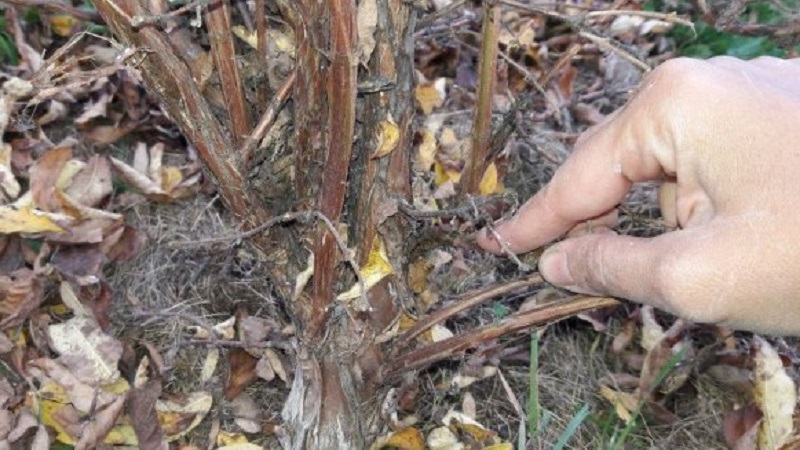
Types of trimming
The formation of the honeysuckle bush begins at the age of 5 years... But if it is seen that the shrub of the first year of life is growing incorrectly, they immediately correct the shape of the bush. Pruning can be formative, rejuvenating, sanitary.
Formative
Formative pruning gives the bush the correct shape. Usually it is carried out at 3-5 years of plant life., repeat after 2 years.
Remove during pruning:
- old non-fruiting branches;
- lower branches resting on the ground;
- young shoots growing deep in the bush;
- branches growing vertically in the depth of the crown;
- extra young growth;
- weakened, thin shoots.
Also shorten branches with weak growth.
Important! Developed one-year-old shoots are not pruned - they will bear fruit next season.
The honeysuckle bush should have about 5-7 strong skeletal branches... Old thick branches are cut to the point of growth of a young shoot.
Anti-aging
Honeysuckle branches grow rapidly, therefore 6-7 year old shrubs require periodic partial rejuvenation... This procedure is necessary so that the crown of the bush does not thicken. Old branches will have weak flowering, poor fruiting. If the shrub is not cut for several years, it will turn into a wild plant.
Rejuvenation is partial and complete depending on the age of the plant. You can see the scheme for rejuvenating an old bush here.
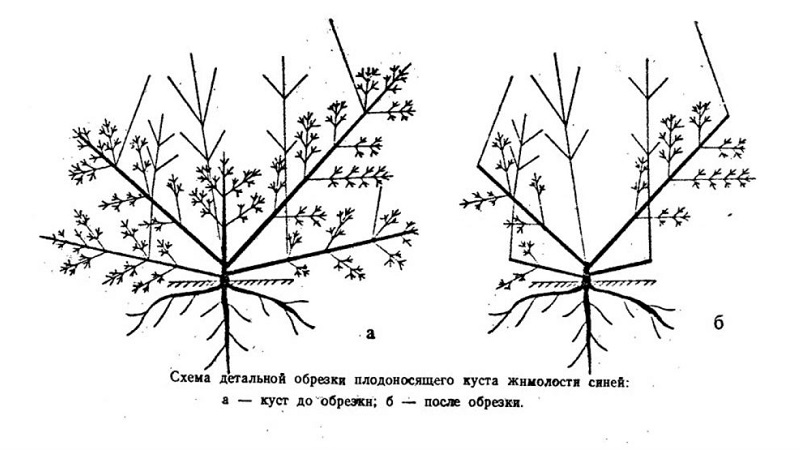
Partial rejuvenation is carried out after 6-8 years of shrub growth... At the same time, they try to thin out the thickened crown as much as possible. The branches close to the base are cut off, which have stalled in growth, leaving a stump 12-15 cm high. Young, healthy shoots will begin to form on it next spring. When pruning, the central young stems are preserved. After the rejuvenation procedure, 6-7 branches should remain.
Reference! Experienced gardeners recommend removing a third of the shoots older than 5 years at a time. The rest is best trimmed next season.
Complete removal of skeletal branches is not recommended, since after such a procedure, the restoration of the crown slows down.
Partial rejuvenation is carried out every 3-4 years... With this agrotechnical method, the fruiting of honeysuckle is prolonged for several decades.
Shrubs, which are more than 13-15 years old, undergo a complete (cardinal) rejuvenation "under the stump"... This procedure is carried out before the onset of cold weather. All branches, regardless of age, are completely shortened, leaving stumps with a height of 45-50 cm. During the next season, active growth of young shoots will occur. After radical rejuvenation, fruiting will occur no earlier than 2 years later.
Sanitary
Sanitary pruning is carried out if necessary... During the procedure, dry, broken branches are removed. Shoots affected by diseases are cut off. In case of severe damage by parasitic insects, branches are also cut off. For the treatment of honeysuckle, branches affected by fungi or pests are cut off along with a small section of a healthy stem.
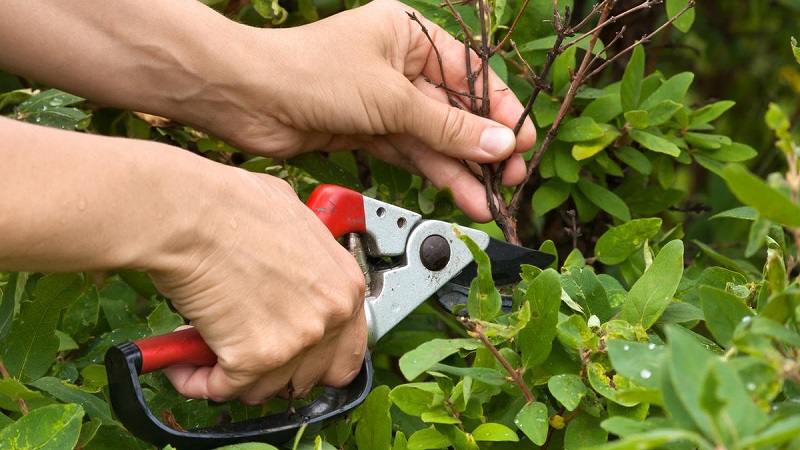
How to prune honeysuckle correctly
For a good harvest and proper shrub formation the procedure is carried out in the coming stage of plant dormancy.
To properly prune, adhere to the following rules:
- rejuvenation and formation of honeysuckle is carried out after leaf fall - during this period the plant does not receive stress from mechanical damage;
- when working, they use only a disinfected, well-sharpened garden tool - a blunt tool will not cut exactly, but remember plant tissues;
- the branches of honeysuckle are fragile, they break easily with careless movement, so the work is carried out carefully, without making efforts to attract the branches;
- to make the plant easier to endure mechanical stress, it is watered the day before the procedure;
- when shortening the branches, take into account that the maximum flexibility is observed in the shoots in the morning;
- do not shorten the upper part of annual shoots;
- the upper parts of perennial branches are removed before branching, since the bulk of dormant fruit buds are concentrated in these places.
Fruiting of honeysuckle occurs only on last year's shoots... The more shoots, the higher the yield of the bush.
Read also:
Guide to pruning sea buckthorn in the fall
Required materials and tools
For pruning you will need tools and materials:
- sharp garden shears or pruning shears;
- trimming garden knife;
- bulk container for collecting cut branches;
- fan rake for collecting small twigs and foliage;
- hacksaw;
- garden ripper;
- gloves;
- fresh mulch.
Pruning schemes
Schemes of formative autumn pruning of shrubs differ depending on the age of the plant.:
- In the first year of the growing season, the apical shoots are shortened, leaving 4 mature buds.
- In the second year of growth, the bush forms several branches. They are also shortened in autumn.
- In the third and fourth years, the resulting honeysuckle shoots in the fall are shortened in the same way, gradually forming a shrub.
- In the fifth year, a stem is formed from 5-8 strong skeletal branches. The lower branches are shortened before the growth of vertical shoots. A gap of 18-20 cm is left between the ground and the lower branches for further processing of the root circle. Remove shoots growing deeper into the bush and darkening the middle of the crown. Crooked, thin branches, broken during the formation of the bush, are also not left.
Step-by-step instructions for pruning
If the honeysuckle bush is more than three years old and the foliage has already been dropped, a scheduled pruning is performed.
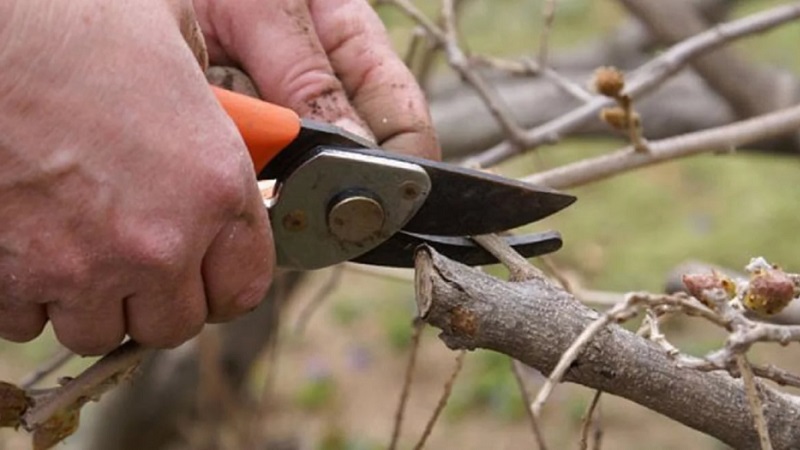
The main stages of work:
- Examine the bush, clean the branches from the remaining dry leaves.
- Inspect the base, clean the root circle with a fan rake from fallen leaves, mulch. Mark out unnecessary lower branches in contact with the soil surface. Choose a garden tool depending on the thickness of the branches to be removed. Thin branches are removed with a sharp secateurs. You will need a sturdy hacksaw to remove thick old branches. Cut branches at an angle of 45 °.
- Remove thin, upright root growth. These branches do not bear fruit, they thicken the shrub. As a result, the plant is poorly ventilated, the middle fruiting branches are poorly lit, there is a rare flowering and lack of pollination.
- Thin the honeysuckle crown. Remove closely spaced, intertwining, interfering twigs. You can not leave sick, weak shoots on the bush.
- Trim short, curved branches. Remove numerous apical shoots resembling an umbrella inflorescence.
- You cannot shorten last year's shoots, since honeysuckle bears fruit only on a one-year-old growth, and the maximum number of fruits is formed at the tops of the shoots. By cutting off such branches, you can be left without a crop.
- Form the plant so that the fruit-bearing branches warm up well, are illuminated by the sun's rays and are available for picking berries.
Eventually you should get an open, well-visible bush with evenly spaced branches in the amount of 13-15 pcs. After processing, the honeysuckle will bear fruit well next season. After the procedure, the soil around the bush is loosened, fresh mulch is laid.
Features of pruning young honeysuckle
Young honeysuckle is not pruned in the early years - first it needs to grow a crown... But if the bush grows in an irregular shape, an adjustment is made. If the roots of the purchased seedling are damaged, the shoots are shortened by a third. This contributes to better survival of a young bush.
Shortening of long shoots stimulates their branching in the future... Some gardeners recommend leaving 10-15 cm long shoots on a young seedling to get a lush crown next season.
Old
After 8 years of life, the bush shows signs of aging... The tops of the branches dry out.The bush becomes thickened, peeling of the bark is observed on the skeletal branches. Young shoots grow poorly, flowering is poor, fruits are almost absent. The plant needs rejuvenation.
Dry areas of branches are removed to the place of formation of tops... With strong aging of the bush, complete pruning of the bush to the state of hemp is recommended. In this case, all branches are cut off, leaving a length of 35-45 cm. Next season, a lush bush will grow from a shortened plant.
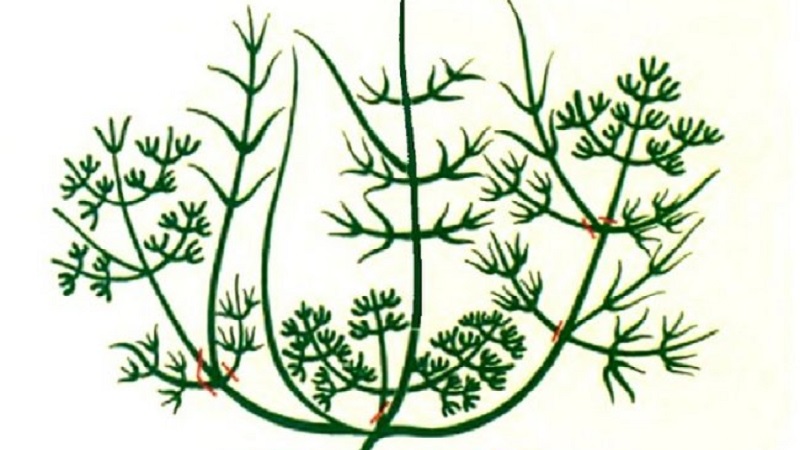
Decorative
Honeysuckle is not only a fruit, but also an ornamental shrub... Ornamental honeysuckle is cut to give it the desired shape. A few shrubs can be used to create a dense hedge. To decorate gazebos, pergolas, liana-shaped honeysuckle is planted. Its size reaches 5-6 m. When growing an ornamental bush in the form of a trunk, shoots are collected in a bunch, fixed to a vertical support. The lower thick branches in the middle of the bush are used as a support. The undergrowth is removed.
Periodic pruning is required to maintain the shape of the hedges.... The first is carried out in early spring, before the buds swell. The branches are shortened to the desired length, dry ones are removed. The shoots are tied up in the right direction. The second pruning is carried out after the end of flowering. Cut off shoots protruding beyond the contour. In autumn, after dropping the foliage, sanitary pruning is carried out.
Slicing processing
The sections are processed to prevent pathogens from entering the tissue... Before processing, they wait until the juice ceases to stand out and the cut dries. A garden variety is used. It is purchased in garden centers or made with your own hands.
For cooking take: 6 parts paraffin, 3 parts rosin, 1 part vegetable oil. Paraffin is heated over low heat, crushed rosin is poured into it, brought to a boil, oil is added. Boil for 15-30 minutes, cool. An elastic mass insoluble in liquid is obtained. Var is applied to the cut sites.
Attention! It is not recommended to use mineral oil for making garden varnish, as it makes it difficult to regenerate damaged plant cells.
Further care
Despite the fact that the shrub is pruned after the end of sap flow, it gets stressed. therefore gardeners advise feeding after the procedure... It is best to apply humus or compost (10 liters for each bush).
The plant is fed with phosphorus, potassium: 10 g of superphosphate, 20 g of potassium sulfate is evenly scattered into shallow grooves around the shrub, then watered with water. Moisten the soil around the bush - this will help the plant to withstand severe cold. Then the honeysuckle root zone is insulated with sawdust, straw.
Conclusion
Annual pruning of fruiting honeysuckle in the fall is a must. It is carried out to remove old, dry, diseased branches, excess growth. With the help of pruning, they correct the shape and thickening of the shrub.
Correct pruning contributes to the improvement of the bush, obtaining larger berries and higher yields in subsequent seasons.